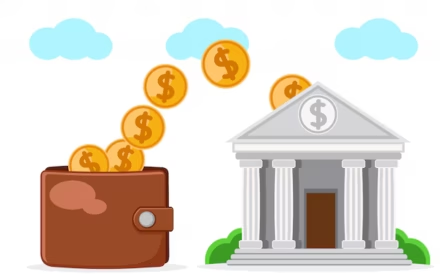Investing is the first step towards a stable financial future. Building an investment portfolio is the foundation. It requires in-depth knowledge of financial markets, analytical skills and experience. Let’s take a closer look at it in this article.

Why an investment portfolio is not an ordinary collection of assets
To really understand what an investment portfolio is, it is important to realise that it is not just a handful of stocks and bonds, but a carefully calibrated system. It is like a garden in which every flower and tree plays a role. Stocks are like bright, fast-growing flowers that can yield a bountiful harvest but need constant attention and care. Bonds, on the other hand, are like sturdy trees that provide a solid foundation, stable income and protect you from financial storms.
Consideration of objectives and level of risk
The approach requires consideration of many factors: risk level, time to reach financial goals and desired returns. The key is to ensure that the foundation not only generates returns but is also fit for purpose, whether that is buying a flat, raising children or retiring early.
How to build an investment portfolio and avoid beginner’s mistakes
 First you lay the groundwork: what do you want to achieve and over what period of time? Then you start choosing assets. Novice investors should avoid overly complex and risky instruments.
First you lay the groundwork: what do you want to achieve and over what period of time? Then you start choosing assets. Novice investors should avoid overly complex and risky instruments.
Common mistakes and how to avoid them
Step by step: define your objectives, select the right assets (stocks, bonds, funds, gold, real estate, cryptocurrencies) and analyse the risks. It is important to remember that each plays a different role:
- Equities. They offer great upside potential, but can be very volatile.
- Bonds. A stable, less risky source of income that offers protection in times of market turbulence.
- Funds. Offer diversification as they cover many assets, reducing overall risk.
- Gold. Traditionally considered a “safe haven” during periods of economic instability, retains value and reduces risk.
- Real estate. Provides stable rental income and increases long-term capital growth.
- Cryptocurrencies. A risky but potentially profitable asset suitable for a small part of a portfolio to increase returns.
A common mistake is to bet on just one type. Analysis of historical data confirms that diversified portfolios show greater return stability than portfolios consisting of one or a few assets. This is because different asset classes have different correlations, which lowers the overall risk level of the portfolio. It is therefore important to create a balanced and sustainable investment portfolio by combining different asset classes to minimise risk.
Portfolio diversification: how to reduce risk and maximise returns
The secret to a healthy investment portfolio is diversification. Imagine a box of sweets, where each candy is a separate asset. If one is not so tasty, the rest will manage. With diversification, you can reduce risk by spreading it across different assets: stocks, bonds, real estate, gold and funds.
Examples and benefits of diversification
This is especially important for novice investors who are not yet prepared for high volatility. If stocks fall, bonds or real estate can help offset the losses. Diversification is a strategic safety cushion that helps maintain a stable base even in the most unpredictable economic conditions.
What assets should be included in an investment portfolio for a successful start from scratch?
For the novice investor, selecting assets can be akin to putting together a construction kit. You should include a variety of “buckets”: stocks for growth, bonds for stability, funds for simplicity and maybe a little real estate. By including different types, you can minimise risk and build a flexible investment portfolio that suits your financial goals and capabilities.
Real examples of return and risk
Statistics prove it:
- Equities can generate significant returns, but they are often subject to extreme fluctuations. For example, the S&P 500 index has a long-term average of around 10%, but some years can show both increases of 20% and decreases of 30%.
- Bonds, on the other hand, offer stable but moderate returns. For example, the return on Russian government bonds is about 7-8% per year, which reduces the overall volatility of the portfolio.
- Funds such as ETFs offer an easy way to invest, even with minimal investment, and have already proven their value. According to the Moscow Stock Exchange, Russian equity ETFs have grown 15% over the past 2 years, making them an attractive tool for beginners.
- And real estate, especially commercial property, is steadily rising in price and providing rental income. Investment in commercial real estate in Moscow, for example, can yield around 10% a year.
- Cryptocurrencies remain risky but potentially profitable assets. Bitcoin, for instance, rose 70% in 2021 and caught the attention of many investors. However, its high volatility requires a cautious approach and portfolio allocation based on risk.
It is best to start with conservative assets and gradually add riskier instruments to build a stable financial base.
How do you choose a broker to build your investment portfolio?
Choosing a broker to build an investment portfolio is an important step that is often underestimated. The main criteria are licensing, commission, ease of use of the platform and availability of research. Imagine the broker is a guide in the investment world. If the guide does not know the way or offers exorbitant prices for services, the journey is unlikely to be pleasant.
Platforms and their features
A licence ensures the safety of your funds and low commissions help you keep your profits. A convenient platform makes investing easy and accessible, even for beginners. Examples of such platforms include Tinkoff Investments, SberInvestor and VTB My Investments. Some brokers offer detailed analysis and training, especially useful for beginners.
Balancing your investment portfolio: what you need to know and do regularly
Balancing your investment portfolio is like maintaining your car: regular maintenance ensures it doesn’t let you down at a key moment. Core assets change in value over time and the original structure may be altered.
How to balance in practice
If stocks rise faster than bonds, the investment portfolio becomes riskier than expected. To avoid this, regularly review the asset allocation and bring it back to the target level. For example, if equities have risen and now hold a larger share, sell some of it and invest the money in more stable assets, such as bonds. This helps maintain an optimal level of risk and keep your investment strategy in line with your financial goals.

It’s time to take action: start your journey to financial freedom
 Regardless of your age and financial situation, you can always find the right strategy and start investing now. A retiree investment portfolio can include conservative instruments that allow you to preserve your savings and receive a stable income. The important thing is to take the first step and then follow the plan with confidence. Financial freedom starts with a small but steady effort.
Regardless of your age and financial situation, you can always find the right strategy and start investing now. A retiree investment portfolio can include conservative instruments that allow you to preserve your savings and receive a stable income. The important thing is to take the first step and then follow the plan with confidence. Financial freedom starts with a small but steady effort.
 en
en  de
de  ar
ar  es
es  nl
nl  hi
hi  fr
fr  it
it  pt
pt  el
el 



